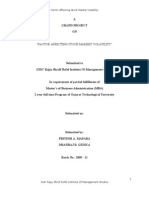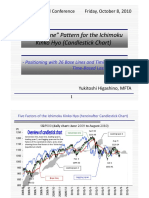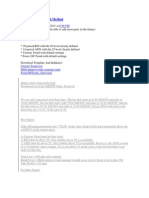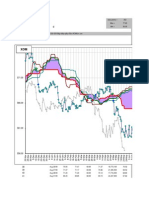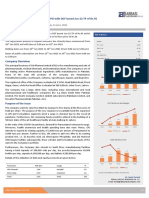Professional Documents
Culture Documents
Chart Types: Line Charts
Chart Types: Line Charts
Uploaded by
Jesus Navalta0 ratings0% found this document useful (0 votes)
81 views2 pagesThere are several types of charts used in technical analysis to visualize market and price data in different ways. Line charts show only the closing price over time, while bar charts show the open, high, low, and closing prices. Renko charts filter out small price movements and focus only on trends. Candlestick charts represent price data as "candlesticks" that indicate the opening and closing prices. Point and figure charts have no time axis and plot price movements without smaller fluctuations. Market profile charts show volume at different price levels throughout the day. Equivolume charts incorporate volume into the width of price bars. High low close bar charts represent each period with the high, low, and closing price.
Original Description:
Original Title
CHART-TYPES
Copyright
© © All Rights Reserved
Available Formats
DOCX, PDF, TXT or read online from Scribd
Share this document
Did you find this document useful?
Is this content inappropriate?
Report this DocumentThere are several types of charts used in technical analysis to visualize market and price data in different ways. Line charts show only the closing price over time, while bar charts show the open, high, low, and closing prices. Renko charts filter out small price movements and focus only on trends. Candlestick charts represent price data as "candlesticks" that indicate the opening and closing prices. Point and figure charts have no time axis and plot price movements without smaller fluctuations. Market profile charts show volume at different price levels throughout the day. Equivolume charts incorporate volume into the width of price bars. High low close bar charts represent each period with the high, low, and closing price.
Copyright:
© All Rights Reserved
Available Formats
Download as DOCX, PDF, TXT or read online from Scribd
Download as docx, pdf, or txt
0 ratings0% found this document useful (0 votes)
81 views2 pagesChart Types: Line Charts
Chart Types: Line Charts
Uploaded by
Jesus NavaltaThere are several types of charts used in technical analysis to visualize market and price data in different ways. Line charts show only the closing price over time, while bar charts show the open, high, low, and closing prices. Renko charts filter out small price movements and focus only on trends. Candlestick charts represent price data as "candlesticks" that indicate the opening and closing prices. Point and figure charts have no time axis and plot price movements without smaller fluctuations. Market profile charts show volume at different price levels throughout the day. Equivolume charts incorporate volume into the width of price bars. High low close bar charts represent each period with the high, low, and closing price.
Copyright:
© All Rights Reserved
Available Formats
Download as DOCX, PDF, TXT or read online from Scribd
Download as docx, pdf, or txt
You are on page 1of 2
ESPIRITU, CHARLENE R.
MWF 2:00-3:00
CHART TYPES
Line charts are the most basic form of charts.
They are composed of a single line from left to right
that links the closing prices. Generally, only the
closing price is graphed, presented by a single
point. It is a clear as well as a simple way of getting
a general idea of the price movement’s direction in
the market, which is preferred by some traders.
While this kind of chart doesn’t provide much
insight into intraday price movements, many
traders consider the closing price to be more
important than the open, high, or low price within a
given period.
Bar charts are also referred to as open-high-low-
close (OHLC) charts. They are comprised of a
series of vertical lines that indicate the price range
during that Time Frame. Bar charts enable traders
to discover patterns more easily as they take into
account all the prices, open, high, low and close.
The opening price is the horizontal dash on the left
side of the horizontal line and the closing price is
located on the right side of the line. If the opening
price is lower than the closing price, the line is often
colored black (or green) to represent a rising
period. The opposite is true for a falling period,
which is represented by a red color.
Renko Chart is a noise-less charting technique
that concentrates merely on price movements,
completely disregarding time and the usage of
volumes. This Chart consists of white/green and
black/red bricks. These are placed depending on
whether the price rose or not compared with the
previous brick. If it did by enough value,
established by the brick size, a new one is placed.
White/Green bricks are used when the price of the
security goes up and black/red bricks when they
go down.
Another kind of chart used in the technical analysis is
the Candlestick chart, so-called because the main
component of the chart which represents prices looks
like a candlestick, with a thick ‘body’ and usually, a
line extending above and below it, called the upper
shadow and lower shadow, respectively. The top of
the upper shadow represents the high price, while the
bottom of the lower shadow shows the low price.
Patterns are formed both by the real body and the
shadows. Candlestick patterns are most useful over
short periods of time, and mostly have significance at
the top of an uptrend or the bottom of a downtrend,
when the patterns most often indicate a reversal of
the trend. The wider part of the candlestick is shown
between the opening and closing price. It is usually
colored in black/red when the security closes on a
lower price and white/green the other way around.The
ESPIRITU, CHARLENE R.
MWF 2:00-3:00
thinner parts of the candlestick are commonly referred to as the upper/lower wicks or as shadows. These show
us the highest and/or lowest prices during that time frame, compared to the closing as well as opening price.
Point & Figure Charts are very unusual as
they feature no timeline along the bottom
horizontal axis. The Chart is made up only of
price swings. The vertical price bar is
arithmetic and shows only units of price. A “O”
is plotted if the price moves down a whole
price unit (for example 50 cents). Then when
the price changes direction and starts to move
upwards an “X” is marked in each box. This
filters out smaller price moves and enables us
to focus on trend quality. Trend lines are
always plotted either horizontally or at 45-
degree angles.
Market Profile Stock Charts The letters on
the chart show time units. “A” represents the
first 30 minutes of trading, “B” represents the
second 30 minutes of trading. The point of
control is the area (price range) at which the
most trades occur during the day. The value
areas are the price range at which 70% of the
action happens. When the price is above
and below the value areas this represents a
possible ideal buying or selling point.
The price at volume chart is an exciting new
development, as instead of showing volume for
a certain time period, it shows us the volume of
trades at a specific price level. This enables us
to see at what price level most of the market
participants believe the stock is fairly priced.
EquiVolume Charts attempt to provide the
solution of Volume at Price in a different way.
Instead of plotting volume in separate bars, it is in
fact incorporated into the price bars
themselves.The wider the price bar, the more
shares were traded during that period.
High Low Close Bar Stock Chart (HLC) Using
bars is a step up from the line chart as is allows
us to plot additional useful data on the chart.
Here we have each bar representing a trading
period with the price High, Low and Close
represented. Refer to the diagram.
You might also like
- Developed by S.B.T. & Mark Larsen: 0.table of ContentsDocument16 pagesDeveloped by S.B.T. & Mark Larsen: 0.table of ContentsJustine SalimNo ratings yet
- Quasidb - Live Data APIDocument428 pagesQuasidb - Live Data APIOndrášek ChaloudupkaNo ratings yet
- Engineering Mathematics by Besavilla Vol 2: Multiple Choice Questions inDocument31 pagesEngineering Mathematics by Besavilla Vol 2: Multiple Choice Questions inAnjo VasquezNo ratings yet
- Project Report On Factor Affecting Stock Market VolatilityDocument154 pagesProject Report On Factor Affecting Stock Market VolatilityPritesh Mapara87% (15)
- KeiretsuDocument17 pagesKeiretsuHimanshu KumarNo ratings yet
- Elect 2Document2 pagesElect 2trishamae100% (1)
- Renko Chart BST - AflDocument3 pagesRenko Chart BST - Afludhaya kumarNo ratings yet
- TARZAN MT4 Indicator - Forex MetaTrader IndicatorsDocument4 pagesTARZAN MT4 Indicator - Forex MetaTrader IndicatorsPapy RysNo ratings yet
- Ichimoku (AATI)Document22 pagesIchimoku (AATI)Anthony FuNo ratings yet
- Range Bars ManualDocument11 pagesRange Bars ManualArtur ZasNo ratings yet
- Protrader Presentation WebDocument30 pagesProtrader Presentation WebraviNo ratings yet
- ASCTrendDocument38 pagesASCTrendAndree W. Kurniawan100% (1)
- Forex Parabolique Sar StrategyDocument3 pagesForex Parabolique Sar StrategyDa VidNo ratings yet
- Installing Renko Script As An EA PDFDocument2 pagesInstalling Renko Script As An EA PDFemilliomudNo ratings yet
- 2.3 - Average Directional Movement Index Rating (ADXR) - Forex Indicators GuideDocument2 pages2.3 - Average Directional Movement Index Rating (ADXR) - Forex Indicators Guideenghoss77No ratings yet
- Arnaud Legoux Moving AveragesDocument6 pagesArnaud Legoux Moving Averagessagarmkale4395No ratings yet
- Trading ViewDocument13 pagesTrading ViewfendyNo ratings yet
- Traders EdgeDocument5 pagesTraders Edgeartus14100% (1)
- PDF Renko Prashant Shah CompressDocument11 pagesPDF Renko Prashant Shah Compressentertainment tvNo ratings yet
- 2010年ベルリン大会東野氏プレゼンテーション資料1 PDFDocument29 pages2010年ベルリン大会東野氏プレゼンテーション資料1 PDFColin LoboNo ratings yet
- Mizuho Corporate BankDocument1 pageMizuho Corporate BankMiir ViirNo ratings yet
- Renko Scalper EA Users Manual GuideDocument2 pagesRenko Scalper EA Users Manual GuideRedeemedNo ratings yet
- Modified Renko Bars ManualDocument3 pagesModified Renko Bars ManualmattpatelNo ratings yet
- Trading Systems IndicatorsDocument3 pagesTrading Systems IndicatorsKam MusNo ratings yet
- E Bortucene C Macy The Day Trade Forex SystemDocument44 pagesE Bortucene C Macy The Day Trade Forex SystemKomang Priatna SuardiNo ratings yet
- ESignal Manual Ch2Document42 pagesESignal Manual Ch2Tatu RrowyoNo ratings yet
- Instructions For The Tig WaveDocument10 pagesInstructions For The Tig WaveIndicatorGuysNo ratings yet
- 480 Bollinger BandsDocument5 pages480 Bollinger BandsUtkarsh DalmiaNo ratings yet
- The Joy of Detrending IiiDocument7 pagesThe Joy of Detrending IiiAnonymous X0iytQQYJ6No ratings yet
- (Trading) TILKIN MACD Divergences Com (PDF)Document3 pages(Trading) TILKIN MACD Divergences Com (PDF)diavolulNo ratings yet
- Vwap For Intraday: EntryDocument5 pagesVwap For Intraday: EntryYash PatilNo ratings yet
- My Trading Diary 2010Document10 pagesMy Trading Diary 2010bokugrahamNo ratings yet
- GBPJPY Daily Trend MethodDocument3 pagesGBPJPY Daily Trend MethodghcardenasNo ratings yet
- Hybrid System of 3 Successful Traders - Engulfing W Pivot & SMADocument8 pagesHybrid System of 3 Successful Traders - Engulfing W Pivot & SMAeduardo montanhaNo ratings yet
- IndicatorDocument31 pagesIndicatorKi SoeroNo ratings yet
- Ichimoku World Weekly Market Analysis by Gabor KovacsDocument14 pagesIchimoku World Weekly Market Analysis by Gabor KovacsKhushi VaishnavNo ratings yet
- Ichimoku Kinko Hyo - A Japanese Technical ToolDocument3 pagesIchimoku Kinko Hyo - A Japanese Technical ToolMadhu50% (2)
- Ichimoku Kinko Hyo Guideline PDFDocument7 pagesIchimoku Kinko Hyo Guideline PDFNgoc Ta0% (1)
- From WoodiesDocument12 pagesFrom WoodiesalexandremorenoasuarNo ratings yet
- Moving AveragesDocument2 pagesMoving Averagesapi-3831404No ratings yet
- IchimokuDocument18 pagesIchimokuindianroadromeoNo ratings yet
- Elementary Mathematics: WwlchenandxtduongDocument15 pagesElementary Mathematics: WwlchenandxtduongAdri adriNo ratings yet
- True Strength IndexDocument2 pagesTrue Strength IndexVincent Lau0% (1)
- Lets Get To Know ForexdssdsDocument28 pagesLets Get To Know ForexdssdsAsad Hamid100% (2)
- Are Simple Momentum Strategies Too Dumb - Introducing Probabilistic Momentum - CSSADocument7 pagesAre Simple Momentum Strategies Too Dumb - Introducing Probabilistic Momentum - CSSAalexmorenoasuarNo ratings yet
- Stochastic RSI - StochRSI DefinitionDocument9 pagesStochastic RSI - StochRSI Definitionselozok1No ratings yet
- How To Use IG Client SentimentDocument7 pagesHow To Use IG Client SentimentRJ Zeshan AwanNo ratings yet
- Cloud Charts - Trading Success With The Ichimoku Technique (PDFDrive - Com) - OCR - Part6Document23 pagesCloud Charts - Trading Success With The Ichimoku Technique (PDFDrive - Com) - OCR - Part6Jean MarcNo ratings yet
- Dynamic Support and Resistance With PitchforkDocument11 pagesDynamic Support and Resistance With PitchforkAnonymous sDnT9yuNo ratings yet
- 005smo PDFDocument5 pages005smo PDFthelearner16No ratings yet
- Bollinger Bands Method - LLDocument4 pagesBollinger Bands Method - LLadoniscalNo ratings yet
- MACD RulesDocument1 pageMACD RulesJafrid NassifNo ratings yet
- ESignal Manual Ch25 JTIDocument4 pagesESignal Manual Ch25 JTIlaxmiccNo ratings yet
- HeikinAshi CandleStick Formulae For MetaStockDocument4 pagesHeikinAshi CandleStick Formulae For MetaStockRaviteja sNo ratings yet
- Moving Average ConvergenceDocument4 pagesMoving Average ConvergenceShivan MohanNo ratings yet
- V32C02718PRPHDocument4 pagesV32C02718PRPHsomeonestupid1969No ratings yet
- Sonic R ManualDocument21 pagesSonic R Manualcalibra55No ratings yet
- IchimokuDocument11 pagesIchimokuvsrb240No ratings yet
- The Dow Powers Above Its 200-Day Simple Moving Average at 10,321Document5 pagesThe Dow Powers Above Its 200-Day Simple Moving Average at 10,321ValuEngine.comNo ratings yet
- Forex Mastery: Smart Strategies by The MastersDocument4 pagesForex Mastery: Smart Strategies by The MastersjjaypowerNo ratings yet
- Trend Trading Buy Sell Signals With The T3 Bands MT4 IndicatorDocument4 pagesTrend Trading Buy Sell Signals With The T3 Bands MT4 Indicatordonald trumpNo ratings yet
- Brooky MACD Ichimoku V2Document5 pagesBrooky MACD Ichimoku V2NeoHoodaNo ratings yet
- Income Inequality and Poverty: Chapter 20Document9 pagesIncome Inequality and Poverty: Chapter 20Bobby HealyNo ratings yet
- B.A. (Economics) - Sem.1 & 2 - (2010-11) PDFDocument12 pagesB.A. (Economics) - Sem.1 & 2 - (2010-11) PDFJaydipRathodNo ratings yet
- HET Marginalist School STDocument41 pagesHET Marginalist School STDogus100% (1)
- Inhouse Software Vs Outsource SoftwareDocument4 pagesInhouse Software Vs Outsource SoftwareIMRAN SALEEMNo ratings yet
- Cement ReportDocument20 pagesCement ReportSudip BaruaNo ratings yet
- Activity Based CostingDocument64 pagesActivity Based CostingAyush100% (1)
- Round 7Document3 pagesRound 7KusnadiNo ratings yet
- ECON 100A Midterm 2 Review SessionDocument64 pagesECON 100A Midterm 2 Review SessionJason WuNo ratings yet
- Full Download Intermediate Microeconomics A Modern Approach 9th Edition Varian Test BankDocument35 pagesFull Download Intermediate Microeconomics A Modern Approach 9th Edition Varian Test Bankeustacegabrenas98% (48)
- Estimating & TenderingDocument13 pagesEstimating & TenderingRoshan de Silva80% (5)
- Vinyl Tiles DupaDocument2 pagesVinyl Tiles DupaJhongz Masing ApolinariaNo ratings yet
- Mooij-Hofstede Convergence Vs DivergenceDocument9 pagesMooij-Hofstede Convergence Vs DivergenceCristina SavaNo ratings yet
- Appendix-A (Solutions To Self-Test Problems)Document34 pagesAppendix-A (Solutions To Self-Test Problems)তি মিNo ratings yet
- A New Commodity Supercycle - Oct 2020Document35 pagesA New Commodity Supercycle - Oct 2020Variant Perception ResearchNo ratings yet
- Van Leer Packaging Worldwide - The TOTAL AccountDocument15 pagesVan Leer Packaging Worldwide - The TOTAL AccountAgarwala Ashesh100% (1)
- Freetoprofits HowJioMukeshAmbani's$30bnstartupwillmakereturns FactorDailyDocument28 pagesFreetoprofits HowJioMukeshAmbani's$30bnstartupwillmakereturns FactorDailyIshu BhaliaNo ratings yet
- Receivables Theories QuizDocument6 pagesReceivables Theories QuizJoovs JoovhoNo ratings yet
- IFM Chapter 17 - Class PresentationDocument15 pagesIFM Chapter 17 - Class PresentationCecilia Ooi Shu QingNo ratings yet
- Debt Instrument Project PDFDocument50 pagesDebt Instrument Project PDFRohit VishwakarmaNo ratings yet
- Abbasi Citi PharmaDocument4 pagesAbbasi Citi Pharmaali ahmadNo ratings yet
- UNIT 10 Vocab Flash CardsDocument8 pagesUNIT 10 Vocab Flash CardsAnonymous bjz5SOJmNo ratings yet
- CH 15 TestDocument21 pagesCH 15 TestDaniel HunksNo ratings yet
- Diana Townhouse in Lancaster EstatesDocument8 pagesDiana Townhouse in Lancaster EstatesdreamtoaddressNo ratings yet
- ECO101-Notes-Ch 1A-Tools of Economic AnalysisDocument9 pagesECO101-Notes-Ch 1A-Tools of Economic AnalysisWallnut JeromeNo ratings yet
- Retrobilling 11.5.10Document9 pagesRetrobilling 11.5.10Muhammad Daniyal KhurshidiNo ratings yet
- RiskCalc 3.1 WhitepaperDocument36 pagesRiskCalc 3.1 Whitepaperiver2340_729926247No ratings yet



